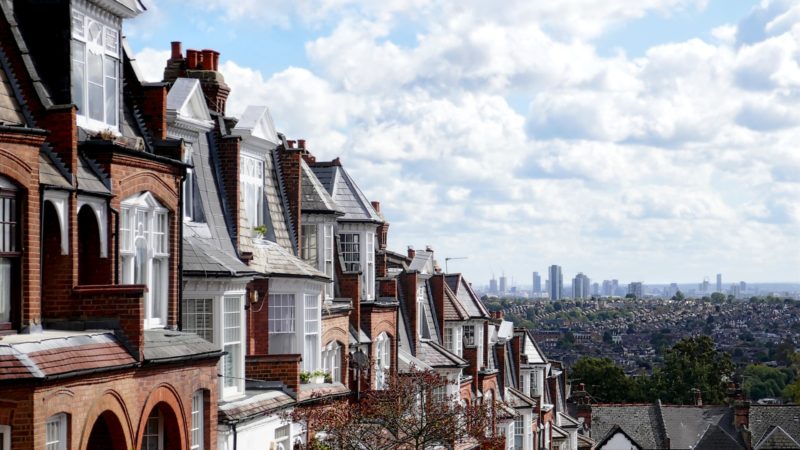Everyone has a basic right to shelter, which they should be able to call home. A home should not be an investment but a place to live. The economy can be positively reconfigured to enable this outcome, as long as we can move away from the destructive emotional propaganda and false assumptions that surround the housing market.
Critics of current housing arrangements argue that our obsession with owning property fuels unsustainable levels of mortgage borrowing and spiralling house prices. But most such critics already own their own homes, and propose no rational basis for deciding who should be allowed this privilege and who should be excluded. They point to countries like Germany, where house-price bubbles are less of a problem as a result of more people renting, and suggest that approach should be copied in countries like Britain and America. There is an unexamined assumption that universal homeownership is impossible under any economic arrangements, but there is an alternative that could make responsible homeowners of us all.
‘Bricks and mortar’ are widely considered a safe investment, but this belief confuses the value of buildings with that of the land those bricks and mortar sit on. It’s true that in boom times house prices and the price of commercial property increase rapidly. But here’s the thing: it’s not the value of a building that appreciates, it is the value of the land on which a building sits. The difference between the value of a house and the land it sits on is easily calculated by reference to the rebuilding cost which is quoted on every buildings insurance policy. Depending on location and size, this ‘restatement’ cost is usually between a quarter and a half of the purchase price of the property. The difference between the restatement cost of a house and its purchase price is the value of the land on which it sits. If you bought a house a decade ago, in many places its ‘value’ will have doubled even if it desperately needs money spent on renovation. Like all capital investments, the value of bricks and mortar decreases over time. This depreciation continues until further investment is made. The value of the land on which a house sits continues to rise regardless of whether the building is properly maintained. Has the householder done something special to bring about this remarkable increase in land value? The answer is no. So there must be an explanation for this; and there is.
Remember that classical economics divides the productive process into three factor classes: land, labour and capital, each of which earns a reward for its contribution. Labour earns wages, capital earns profits and land earns rent. This use of the term rent is confusing. It is not the same as the rent you pay to occupy a home that is owned by someone else. In economic terms, land rent is the amount someone is prepared to pay to use a plot of land.
The classical economist Henry George defined land rent as “the part of the produce that accrues to the owners of land (or other natural capabilities) by virtue of ownership.” If there was abundant spare land, and it was not subject to private ownership, anyone could assume control of a plot of land at no cost. But because the supply of land is fixed – in Mark Twain’s words, “they’re not making it any more” – it can’t be increased by human intervention. So when all land is privately owned, landowners find themselves at an advantage: they can charge non-landowners for the right to use their land. And non-landowners have no choice but to pay.
If the ownership of land could be shared equally between all citizens globally, then nobody would be at any particular advantage. Some people might choose not to occupy all their land, and ‘rent’ out their spare land to a neighbour who required more. But if the ownership of land is not equally shared – as is the case today in every country – the small minority who do own most land are at a huge advantage.
In the UK, seventy per cent of land is owned by just one per cent of the population. This gives immense economic power to a small number of landowning individuals and corporations.
The value of land differs widely from place to place. Back when the economy was mainly agricultural, differences in the fertility of land accounted for variations in the amount people were prepared to pay for its use. Nowadays, zoning or planning laws have more of an impact. Land in areas where commercial development is permitted commands a higher price than land reserved for agricultural use. But the biggest factor influencing differences in land values today is location. Land in or near the central business district of a major city commands the highest price; land suitable for industrial use with good communications links will also be expensive; land set aside for residential use will be attractive especially in popular locations and when there is a shortage of housing relative to demand. Land upon which nothing can be built or grown, which has possibilities only for grazing animals, will be among the cheapest.
Among the classical economists, it was David Ricardo who best described the effects of the finite supply of land and the impact of economic potential on its value. Because of its fixed supply, land commands a greater share of the income earned from production than it otherwise would, and the best land earns the most. The extra revenue earned by the supplier of land reduces that paid for the contributions of labour and capital. Again, this would not be a problem if the benefits of landownership were divided equally among the population, but they are not. Ownership, especially of the most valuable and in-demand land, is concentrated in the hands of a small minority, who, like bankers, enjoy the benefits of an economic privilege that has not been granted by democratic consent.
This skewed economic mechanism is what land reformers refer to when they say land values arise not from the efforts of the land owner, but of the wider community. Land values rise automatically over time because landowners enjoy a disproportionate share of the returns from economic activity. John Stuart Mill called this the “unearned increment of land”. He then put it more bluntly: “it’s the income that landlords make in their sleep.” You could call this increase the ‘general uplift’ in land values. It’s a subtle mechanism that attracts little attention. Economists don’t like to talk about it, and very few people are aware of it. With such easy, unchallenged spoils on offer, it’s not surprising that the wealthiest individuals and largest corporations have large stakes in land ownership.
Much of this general uplift in land values results from government investment in public infrastructure projects funded by taxpayers. If billions are spent on a new railway line, then the value of land in the vicinity of the investment will rise. Improved communication links make any area more favourable to business, but even before a new wave of customers has crossed the threshold, the owners of business and residential property have seen the value of their landholdings rise considerably. This is not because of any effort they have expended, or investment they have made, but simply because they happen to own land in an area chosen for infrastructure investment. In the case of business landowners, not only do they have improved access to customers, but the collateral value of their landholdings also makes it easier for them to borrow funds to expand their businesses. This is the kind of monopoly-favouring mechanism that Adam Smith warned about. These tax-funded increases in private wealth amount to an unwarranted direct transfer of wealth from ordinary people to business owners. It is the providers of the original funds – taxpayers – who should recoup the proceeds from such investments. Instead, the benefits accrue entirely to privately-owned businesses, landowners and fortunate homeowners.
Landowners do frequently make investments to improve their land. For example, they may build a shopping centre on a plot that previously had no use. This investment involves labour and capital, each of which demand and deserve a return. In this scenario, if the landowner is also the supplier of capital, then he is entitled to make a profit. But this is a reward for his risking his capital. It is quite different from any increase in his wealth derived from the general uplift in land values, to which he is not entitled.
The unique nature of land among all the factors of production is apparent. It’s remarkable therefore that the dominant neo-classical model of economics pays no attention to land whatsoever; or is it, perhaps, deliberate?
Increases in the value of residential land occur in the same way. Such land shares in the general uplift in value – created by the community – that applies to all land over time. But this is only half the story. During economic boom times the general uplift or unearned increment is only partially responsible for the rapid increase in the value of residential property. Three others factors play a significant role:
First is the supply of housing relative to demand. Over the last several decades, the number of households in the UK has grown at a rate far in excess of the number of homes, partly because the authorities have stopped adding to the stock of affordable social housing.
Second is the failure of private-sector house builders to fill the gap. This is not surprising given that private firms will only build houses if they can make a profit. If the demand for housing at the bottom end of the market is not ‘effective’ then no affordablehomes will be built.
The third factor – and the one most responsible for the dysfunctional state of the housing market-is the money made available to people who can ‘afford’ to buy their own homes. At the top end of the market this comes in the shape of the excessive salaries paid to top executives of large firms and the absurd bonuses paid to many in the banking sector. While these super-high earners may be few in number, they drive up prices at the top and the impact reverberates downwards. If a house that cost £1 million five years ago is now ‘worth’ £2 million, then one that previously cost £500,000 will now be assumed to be worth £1 million. As there are not enough highly paid executives to meet the supply of smaller, less well-located homes at £1 million, people on more typical salaries are encouraged to take out mortgages to buy these houses which, only a few years earlier, would have been priced far more cheaply relative to their income.
In order to sustain this upward spiral in house prices, banks are only too happy to keep lending. (Loan interest, remember, is the principal source of banks’ profits.) They consider a loan to be safe as long as it is backed by collateral in the shape of a home, and the inflated value of the land it sits on, worth £1 million. They care not that the price is determined only by the amount of money they are prepared to lend, or that the entire process creates a dangerous asset bubble in land prices.
As we know, when a bank makes such a loan it creates the money from nothing. We also know that the bonuses paid to bankers and others who ply their ’trade’ in the financial sector are not backed by real wealth. So, with the inflated pay of executives outside the financial sector being driven by the labour market, it’s logical to conclude that house price inflation over and above the general uplift in land values is driven entirely by the way the banking system works.
A similar process explains the high cost of commercial property. Absurdly, the process of profit-motivated money creation driving up land values has created a situation where the most valuable land in the world is occupied by the office blocks from which the banks carry on their dubious business.
It would be unfair to criticize homeowners for using their houses as cash machines, given the daily struggle of surviving on wages constantly eroded by the effects of inflation driven by uncontrolled growth in the money supply. But there is a better way of arranging the housing market. We need to untangle the provision of housing – a basic human right – from a banking system motivated by profit. We need to learn the lessons of history, especially how land speculation and the asset bubbles it causes can derail the wider economy. The dysfunctional housing market is inextricably linked to the way banks are allowed to create money. By changing the way the banking system works and by ensuring that real wealth from the productive economy does not end up in land values, we can begin to move towards a society in which the dream of universal, sustainable home ownership can become a reality.
Excerpt from Four Horsemen: The Survival Manual.

Designer and CEO of Open Systems Lab, Alistair Parvin and engineer and home buyer, Paul Smith joined with Renegade Inc. to help people navigate this new build house financial racket.

In Britain the mortgage market is worth more than one point three trillion pounds. But how many of these mortgages are fatally flawed?

The average Briton is only ever about two sentences away from discussing house prices. Why? Because the British land market is utterly dysfunctional.